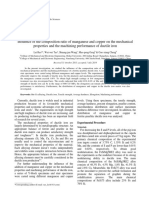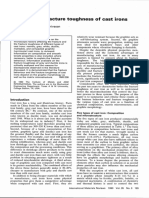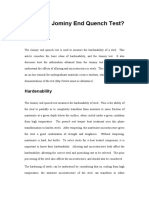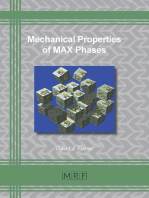SG Cast Iron
SG Cast Iron
Uploaded by
Surendra KamalCopyright:
Available Formats
SG Cast Iron
SG Cast Iron
Uploaded by
Surendra KamalCopyright
Available Formats
Share this document
Did you find this document useful?
Is this content inappropriate?
Copyright:
Available Formats
SG Cast Iron
SG Cast Iron
Uploaded by
Surendra KamalCopyright:
Available Formats
Effect of alloying elements (Mainly Nickel) on mechanical properties of S G cast iron
Scope This document covers the study of effects of reduction in Nickel content from 0.7% to 0.5% on mechanical properties of Spheroidal Graphite Cast Iron. Introduction Ductile cast iron or SG Iron exhibits good ductility and toughness because of the graphite morphology is spherical. SG Iron has many advantages such as high strength and toughness, high machinability and medium corrosion resistance. The small additions of Mo, Mn, Cu, Ni and Cr changed the as-cast mechanical properties owing to the different as-cast matrix microstructures. The ferrite matrix of Mo and Ni alloyed cast iron exhibits low strength and hardness as well as high elongation and impact energy. The increase in Mo and Ni contents developed some fractions of pearlite structures near the austenite eutectic cell boundaries, which caused the elongation and impact energy to drop in a small range. Adding Cu and Cr elements rapidly changed the ferrite matrix into pearlite matrix, so strength and hardness were significantly increased. Following table shows the chemical composition of different SG cast iron by wt percentage.
Microstructure
Table 1: Chemical Composition of Nodular Cast Iron
Figure 1 shows the as-cast microstructure of SG Cast iron. The micrograph shows that the matrix structure is fully ferrite structure with a small fraction of pearlite near the eutectic cell boundaries. The spheroidal graphite nodules are well distributed within the ferrite matrix. Two types of graphite in size are observed microscopically.
Ferrite Phase*
Pearlite Phase**
Graphite Nodules Figure 1 Microstructure of Spheroidal Graphite Cast Iron
01 of 03
*Ferrite Phase: It is generally a soft constituent, but it can be solid solution hardened by silicon. The ferrite matrix is readily machined but exhibit poor wear resistance. **Pearlite Phase: A combination of ferrite and cementite, it consists of alternate layer of ferrite and iron carbide. It is very strong and tough. The hardness, strength, machinability and wear resistance of pearlite matrices vary with the fineness of its lamination.
Image analysis of volume fraction, nodule count, nodularity and average diameter of graphite on the different alloyed ductile cast irons are given in Table 2. Increase in nodularity percentage/count, higher the ductility of the cast iron.
Table 2: Characteristics of Spheroidal Graphite Cast Iron
Effect of alloying elements on SG Cast Irons The result of chemical analysis indicates the alloying elements obtain a mixture of ferrite and pearlite in the matrix microstructure. The ferritic-pearlitic and fully pearlitic matrix obtained by the reaction with manganese and phosphorus. Each alloying elements are kept at appropriate levels to obtain the microstructures and mechanical properties required by ductile iron standards. Manganese functions as an alloying element, increasing the hardness and strength of ferrite, stabilizing and refining the pearlite. Increase in manganese content, results in significant increases in tensile and yield strength. Nickel is weak pearlite promoter and strengthens ferrite phase. The contribution of nickel to hardenability is significantly enhanced by additions of molybdenum. It helps in increasing the strength without affecting the impact values. Due to the high cost it is generally present as traces in the matrix. Copper is strong pearlite promoter, It is commonly used to develop pearlitic microstructures, Copper decreases the ferrite content in favor of pearlite formation and increases strength and hardness through increased pearlite formation. Chromium is a pearlite promoter in ductile iron but its reaction depends up on the nodule count. Nickel, copper and molybdenum have to be carefully added because they influence on the matrix microstructure with severity when are added to the cast, Besides, they have important effects on hardness, strength and on corrosion. Mechanical Properties of as-cast SG Iron Below figure 2 shows the variation of tensile strength and elongation of nodular cast iron having different alloying contents. With the increase in the amount of Mo and Ni additions, tensile strength is slightly increased while elongation is decreased. The strength of Mo and Ni alloyed ductile cast iron is mainly dependent on the solid solution hardening of ferrite matrix. It was also considered that the decrease in elongation was caused by the increase in pearlite formation. 02 of 03
Figure 2 : Tensile and Elongation Properties
Figure 3 shows the variation in hardness and impact energy with different alloying additions. As more alloying contents are added, the Brinell hardness of Mo and Ni alloyed ductile cast iron is linearly increased, but that of Cu and Cr alloyed ductile cast iron increased very steeply. The Brinell hardness of ductile cast iron refers to the resistance of the matrix and graphite to plastic deformation. The variation in hardness with the alloying element is strongly determined by the as-cast microstructures. Generally, the hardness of cast iron is increased by the volume fraction of pearlite structure. In this study, the addition of Mo and Ni slightly increased the matrix hardness via solid solution hardening. As more Cu and Cr element is added, the hardness increased significantly owing to the high fraction of pearlite.
Figure 3: Hardness and Impact Properties
The Charpy impact energy of Mo and Ni alloyed iron is gradually decreased, but that of the Cu and Cr alloyed iron begins to decrease fast. This indicates that ferrite matrix provides highly ductile cast iron while pearlite yields highly strong cast iron. Mo was found to reportedly segregate at cell boundaries and aggravate the toughness of ductile cast iron. However, the toughness of ductile cast iron was more dependent on the area fraction of ferrite than the area fraction of intercellular carbide-like phases. Conclusion: 1) Reduction in Ni content from 0.75% to 0.50% will increase the percentage elongation upto some extent. Tensile strength of ductile cast iron depends upon the C & Mo content. 2) Hardness decreases and charpy impact energy (toughness) increases as Ni content decreases from 0.75 to 0.50%. 3) Ni addition is week pearlite promoter and strengthen ferrite phase. As the pearlite phase increases the hardness increases and ductility decreases. 4) Higher the percentage of graphite nodules (> 90%), higher the ductility and toughness.
03 of 03
You might also like
- Number of NeutronsDocument3 pagesNumber of Neutronsstephanie rose ayunayun67% (3)
- SG Iron MachiningDocument8 pagesSG Iron Machiningkumar kmNo ratings yet
- Ductile Iron Documents 1Document277 pagesDuctile Iron Documents 1emir_osman5940No ratings yet
- Effect of Alloying Elements On Microstructure and Mechanical Properties of Ductile IronDocument5 pagesEffect of Alloying Elements On Microstructure and Mechanical Properties of Ductile IronIjabiNo ratings yet
- Ferro Fundido CinzentoDocument3 pagesFerro Fundido CinzentoCarlos LaoNo ratings yet
- Gray Iron Alloys FEB05Document7 pagesGray Iron Alloys FEB05eureka_sedna966No ratings yet
- Ductile Iron Casting Guide FEB05Document3 pagesDuctile Iron Casting Guide FEB05Aris YusepNo ratings yet
- Castro2011 PDFDocument9 pagesCastro2011 PDFArmando Lujan VelazquezNo ratings yet
- Ijems 21 (5) 573-579Document7 pagesIjems 21 (5) 573-579abhiNo ratings yet
- Property Optimization in As-Quenched Martensitic Steel by Molybdenum and Niobium AlloyingDocument22 pagesProperty Optimization in As-Quenched Martensitic Steel by Molybdenum and Niobium AlloyingAlberto CorreaNo ratings yet
- Microstructure Developed in LAS & MSDocument22 pagesMicrostructure Developed in LAS & MSSatyendra SinghNo ratings yet
- Topic 4: Classification, Properties and Applications of S.G. and C.G.Iron S.G.IRONDocument11 pagesTopic 4: Classification, Properties and Applications of S.G. and C.G.Iron S.G.IRONsandeep kumarNo ratings yet
- Solution Strengthened Ferritic Ductile Iron ISO 1083/JS/500-10 Provides Superior Consistent Properties in Hydraulic RotatorsDocument9 pagesSolution Strengthened Ferritic Ductile Iron ISO 1083/JS/500-10 Provides Superior Consistent Properties in Hydraulic RotatorsJason WuNo ratings yet
- Trends Production Ultrafined Grain Steel PDFDocument43 pagesTrends Production Ultrafined Grain Steel PDFNorma BarajasNo ratings yet
- On The Microstructure and Mechanical Properties of Automotive Parts Made of Ductile IronDocument21 pagesOn The Microstructure and Mechanical Properties of Automotive Parts Made of Ductile IronXantos YulianNo ratings yet
- Applied Metallurgy by WMDocument162 pagesApplied Metallurgy by WMwilson moNo ratings yet
- Chapter 7. Ferrous and Non-Ferrous AlloysDocument14 pagesChapter 7. Ferrous and Non-Ferrous AlloysVishal ShuklaNo ratings yet
- Effect of Deoxidizer On Microstructure and Mechanical Properties of Micro Slag Gas Shielded Flux Cored WireDocument11 pagesEffect of Deoxidizer On Microstructure and Mechanical Properties of Micro Slag Gas Shielded Flux Cored WireBhushan DharmikNo ratings yet
- Baker TN Ironmaking and Steelmaking 2015 Microalloyed SteelsDocument179 pagesBaker TN Ironmaking and Steelmaking 2015 Microalloyed SteelsCarla FerreiraNo ratings yet
- Development of Nickel-Added, Iron-Based, Slag-Free, Self-Shielded Metal-Cored WireDocument10 pagesDevelopment of Nickel-Added, Iron-Based, Slag-Free, Self-Shielded Metal-Cored WireFeray Kebeli AvcıNo ratings yet
- The Effect of Increasing Silicon On Mechanical ProDocument7 pagesThe Effect of Increasing Silicon On Mechanical ProSunil ShrivastavaNo ratings yet
- Fracture and Fracture Toughness of Cast Irons: W. L. Bradley and M. N. SrinivasanDocument33 pagesFracture and Fracture Toughness of Cast Irons: W. L. Bradley and M. N. SrinivasanNarasimha Murthy InampudiNo ratings yet
- 73 Ijmperdjun201973Document6 pages73 Ijmperdjun201973TJPRC PublicationsNo ratings yet
- Gray IronDocument9 pagesGray Ironiamraghu2309100% (1)
- The Effect of Vanadium Micro Alloying and Hot Deformation Control On The Mechanical Properties of Structural SteelDocument4 pagesThe Effect of Vanadium Micro Alloying and Hot Deformation Control On The Mechanical Properties of Structural SteelHany KhalifaNo ratings yet
- AnalysisDocument16 pagesAnalysispatilayush1894No ratings yet
- 4.2.4 The Influence Cast Microst Upon Fract Toughn Fatigue Propert.Document9 pages4.2.4 The Influence Cast Microst Upon Fract Toughn Fatigue Propert.AlexandreinspetorNo ratings yet
- Modification of Fe-Cr-C Alloys Using Mischmetal PDFDocument3 pagesModification of Fe-Cr-C Alloys Using Mischmetal PDFFàtí ĐCNo ratings yet
- Effect of Copper in Structural SteelDocument1 pageEffect of Copper in Structural SteelUthayakumarNo ratings yet
- CF6 2013 MicrostructureDocument5 pagesCF6 2013 MicrostructureJ. VanajaNo ratings yet
- Recent Trends in Producing Ultrafine Grained Steels: Hossam HalfaDocument43 pagesRecent Trends in Producing Ultrafine Grained Steels: Hossam Halfaannal65No ratings yet
- An Investigation On The Weldability of Grey Cast Iron Using Nickel Filler MetalDocument5 pagesAn Investigation On The Weldability of Grey Cast Iron Using Nickel Filler MetalKhin Aung ShweNo ratings yet
- A Metallographic Examination of Fracture Splitting C70S6 Steel Used in Connecting RodsDocument14 pagesA Metallographic Examination of Fracture Splitting C70S6 Steel Used in Connecting RodsSujay NahaldeNo ratings yet
- Microstructure and Mechanical Properties of A Bainitic PM SteelDocument14 pagesMicrostructure and Mechanical Properties of A Bainitic PM SteeldonnizanthNo ratings yet
- Cast IronDocument12 pagesCast IronCarlos EsparzaNo ratings yet
- Materials and Design: Surajit Kumar PaulDocument10 pagesMaterials and Design: Surajit Kumar PaulOmar S Al-AbriNo ratings yet
- What Is A Jominy End Quench Test?Document18 pagesWhat Is A Jominy End Quench Test?faqhrulNo ratings yet
- Case-Hardening Steel: Everything That Moves Needs Case-Hardened GearsDocument5 pagesCase-Hardening Steel: Everything That Moves Needs Case-Hardened GearsjeyakumarNo ratings yet
- High Silicon Infleunce of Heat Treatment AnnealingDocument9 pagesHigh Silicon Infleunce of Heat Treatment AnnealingFernando Martinez ContrerasNo ratings yet
- Effects of MN and NB On The Macro-And Microsegregation in High-Mn High-Al Content TRIP SteelsDocument10 pagesEffects of MN and NB On The Macro-And Microsegregation in High-Mn High-Al Content TRIP SteelsKhairul MuzafarNo ratings yet
- Microstructural Constituents in SteelsDocument18 pagesMicrostructural Constituents in Steelssx mhvNo ratings yet
- 2014 IJMERR SAW v3 n3 483-491Document12 pages2014 IJMERR SAW v3 n3 483-491Anang MarufNo ratings yet
- Dual Phase SteelsDocument43 pagesDual Phase SteelsLuis MendozaNo ratings yet
- Inoculation of Grey and Ductile Iron A Comparison of Nucleation Sites and Some Practical AdvisesDocument12 pagesInoculation of Grey and Ductile Iron A Comparison of Nucleation Sites and Some Practical AdvisesZody YtuNo ratings yet
- The Role of Niobium in Austenitic and Duplex Stainless SteelsDocument25 pagesThe Role of Niobium in Austenitic and Duplex Stainless SteelsZoe SideriNo ratings yet
- 03.effects of Alloying ElementsDocument8 pages03.effects of Alloying Elementsandrian hermanNo ratings yet
- Effect On The Mechanical Properties of Gray Cast Iron With Variation of Copper and Molybdenum As Alloying Elements IJERTV3IS050215Document4 pagesEffect On The Mechanical Properties of Gray Cast Iron With Variation of Copper and Molybdenum As Alloying Elements IJERTV3IS050215Aniket LimbekarNo ratings yet
- Development of Medium Carbon Steel Wire Rods For Cold Heading by Isothermal Transformation TreatmentDocument6 pagesDevelopment of Medium Carbon Steel Wire Rods For Cold Heading by Isothermal Transformation TreatmentSmruti Ranjan PattanayakNo ratings yet
- AHSS RKuziakDocument16 pagesAHSS RKuziakJesus Ismael Jimenez GarciaNo ratings yet
- Cast Iron PropertiesDocument8 pagesCast Iron PropertiesGerardo JM Palacios100% (1)
- Heat Treatment of CastingDocument15 pagesHeat Treatment of CastingjmmshahNo ratings yet
- Cast Irons: Job Knowledge 25 Weldability of MaterialsDocument3 pagesCast Irons: Job Knowledge 25 Weldability of Materialskevin herryNo ratings yet
- The Effects of Niobium Microalloying in Second Generation Advanced High Strength SteelsDocument12 pagesThe Effects of Niobium Microalloying in Second Generation Advanced High Strength SteelsemregnesNo ratings yet
- A New Method of Characterizing and Quantifying Complex Microstructures in SteelsDocument12 pagesA New Method of Characterizing and Quantifying Complex Microstructures in SteelsronaldoNo ratings yet
- Cast Iron: A Widely Used MaterialDocument19 pagesCast Iron: A Widely Used MaterialHarshaDesuNo ratings yet
- Effect of Allowing Elements in Cast IronDocument11 pagesEffect of Allowing Elements in Cast IronNiladri BiswasNo ratings yet
- Metallurgy Unlocked Mastering Metallurgical Diploma Questions and AnswersFrom EverandMetallurgy Unlocked Mastering Metallurgical Diploma Questions and AnswersNo ratings yet
- Galvanising CertificateDocument1 pageGalvanising CertificateSurendra KamalNo ratings yet
- 311 Hansen Zinc PlatingDocument2 pages311 Hansen Zinc PlatingSurendra KamalNo ratings yet
- Welding Inspection: Multi-Choice Questions Paper 1 Please Return This Paper UnmarkedDocument4 pagesWelding Inspection: Multi-Choice Questions Paper 1 Please Return This Paper UnmarkedSurendra KamalNo ratings yet
- Images InterpretrationDocument1 pageImages InterpretrationSurendra KamalNo ratings yet
- PT Level-2Document22 pagesPT Level-2Surendra KamalNo ratings yet
- CorrosionDocument65 pagesCorrosionSurendra Kamal100% (9)
- Welding Defects: BY BYDocument63 pagesWelding Defects: BY BYSurendra KamalNo ratings yet
- Cswip-3 2Document55 pagesCswip-3 2Surendra KamalNo ratings yet
- 33B 1 1Document774 pages33B 1 1Guille PeroniNo ratings yet
- Welding Procedure PreparationDocument122 pagesWelding Procedure Preparationthe_badass1234100% (21)
- One Mark Questions: Subject: Chemistry Chapter - 11: P-Block ElementDocument13 pagesOne Mark Questions: Subject: Chemistry Chapter - 11: P-Block ElementudaysrinivasNo ratings yet
- Chem Equations Worksheet 3Document11 pagesChem Equations Worksheet 3aubideeNo ratings yet
- Shop Parctice No. 6.2 Molding Practice 2Document8 pagesShop Parctice No. 6.2 Molding Practice 2Patrick James RoseteNo ratings yet
- Preparation of Mohr SaltDocument16 pagesPreparation of Mohr SaltDhruv67% (3)
- Reason For Different Solubility of Alkali Metal Chlorides in Cadmium Nitrate SolutionDocument2 pagesReason For Different Solubility of Alkali Metal Chlorides in Cadmium Nitrate SolutionAndini Nurkaton100% (1)
- Šoštarić 2018Document43 pagesŠoštarić 2018imran shaukatNo ratings yet
- LCT 1Document19 pagesLCT 1Julia MaramatNo ratings yet
- Dyeing of Textile Material NotesDocument41 pagesDyeing of Textile Material NotesMd Abu Shalea 125No ratings yet
- Effects of Plasma Activated Water On WheatDocument14 pagesEffects of Plasma Activated Water On WheatIoana LețiNo ratings yet
- Rubber Material Reference, Neoprene, EPDM, Buna-N, Silicone, SBR, Butyl, Natural Rubber, Gum Rubber, Hypalon, Urethane, Viton, Fluoroelastomer, Fluoro Silicone, Hydrogenated Nitrile, Carboxylated NitrileDocument3 pagesRubber Material Reference, Neoprene, EPDM, Buna-N, Silicone, SBR, Butyl, Natural Rubber, Gum Rubber, Hypalon, Urethane, Viton, Fluoroelastomer, Fluoro Silicone, Hydrogenated Nitrile, Carboxylated NitrileDv Maria Pradhika0% (1)
- Superfort Multi Ply Conveyor Belt Leaflet EnglishDocument2 pagesSuperfort Multi Ply Conveyor Belt Leaflet EnglishRaji VargheseNo ratings yet
- UV-VIS Ruta GraveolensDocument4 pagesUV-VIS Ruta GraveolensKARINA LUNANo ratings yet
- Synthesis of An Alkyl HalideDocument4 pagesSynthesis of An Alkyl HalideRuther CabralNo ratings yet
- Brochure (EN) - Röhm's Expertise For Tailormade HCN SolutionsDocument7 pagesBrochure (EN) - Röhm's Expertise For Tailormade HCN SolutionsJayakumar ANo ratings yet
- Flow Solution FS 3700 Automated Chemistry AnalyzerDocument16 pagesFlow Solution FS 3700 Automated Chemistry AnalyzerMiguel Angel Hanco ChoqueNo ratings yet
- Merck Indian 2024Document33 pagesMerck Indian 2024sale.shaswattradersNo ratings yet
- Practice Test Qumica Grado 11Document2 pagesPractice Test Qumica Grado 11Miguel Emilio HernandezNo ratings yet
- Thermodynamic Model SelectionDocument12 pagesThermodynamic Model Selectionnarayana reddyNo ratings yet
- Lutensol AT 25 EDocument2 pagesLutensol AT 25 EMovie Holic100% (3)
- Materials For Hip Prostheses: A Review of Wear and Loading ConsiderationsDocument26 pagesMaterials For Hip Prostheses: A Review of Wear and Loading ConsiderationsEka NatsvlishviliNo ratings yet
- Summative TestDocument72 pagesSummative TestJohn Van Dave Taturo100% (2)
- Determination of Paraformaldehyde Reactivity and Its Relationship To PRF Resin GelationDocument6 pagesDetermination of Paraformaldehyde Reactivity and Its Relationship To PRF Resin GelationNam Phạm VănNo ratings yet
- The Howling Screaming Jelly Baby SWDocument3 pagesThe Howling Screaming Jelly Baby SWGideon CavidaNo ratings yet
- 1 s2.0 S2667064X2400304X MainDocument90 pages1 s2.0 S2667064X2400304X MainOdeke DanielNo ratings yet
- Cazón, P. Vázquez, M. Velazquez, G. Composite Films With UV-Barrier Properties Based On Bacterial Cellulose Combined With Chitosan and Poly (Vinyl AlcoholDocument36 pagesCazón, P. Vázquez, M. Velazquez, G. Composite Films With UV-Barrier Properties Based On Bacterial Cellulose Combined With Chitosan and Poly (Vinyl AlcoholanikbdtrainNo ratings yet
- Ashraf, Mahmood, Dan Wajid (2011) PDFDocument9 pagesAshraf, Mahmood, Dan Wajid (2011) PDFMiranti PuspitasariNo ratings yet
- Chemistry Experiments Class XDocument7 pagesChemistry Experiments Class XconfidosurculusgamerzNo ratings yet
- Higher AH Chemistry Data BookletDocument21 pagesHigher AH Chemistry Data Bookletshuhratjonovd2No ratings yet
- Organic Chemistry: Exercise - I Exercise - Ii Exercise-Iii Exercise Iv Answer KeyDocument39 pagesOrganic Chemistry: Exercise - I Exercise - Ii Exercise-Iii Exercise Iv Answer KeyRaju SinghNo ratings yet



































































































